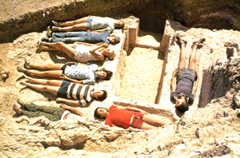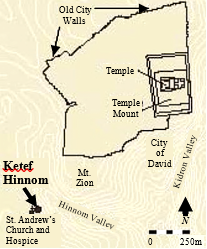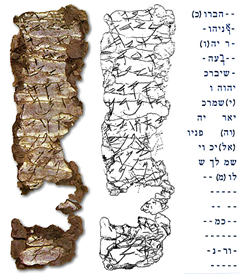There are times in archaeology’s history of incredible finds that God inserts His own sense of irony. Where is the wise? where is the scribe? where is the disputer of this world? hath not God made foolish the wisdom of this world? Case in point: prior to 1979, many impressive academic scholars, well credentialed, well respected and published, maintained that the five books of Moses were written in Babylon, not by Moses, but by a spunky group of Jewish patriates seeking to reinvent history to cover up their embarrassing beginnings. Why not spice it up with a bunch of miraculous myths?
Enter Israeli archaeologist Gabriel Barkay, and his team of under-age assistants. One 13-year-old boy was particularly annoying to Barkay, whose use of child labor to help with the mundane tasks of digging and sifting was beginning to feel like work. He gave the annoying teenager a task: clean around this tomb area so I can make a photograph. The boy quickly did that, got bored, and took out his hammer. That’s when he broke open the door to a sizable burial chamber full of ancient artifacts hidden from the millennia of tomb raiders (see picture, right). And that’s when Barkay made the discovery of his career: the oldest known Hebrew inscriptions of The Old Testament (OT), dating to the days of Jeremiah.
got bored, and took out his hammer. That’s when he broke open the door to a sizable burial chamber full of ancient artifacts hidden from the millennia of tomb raiders (see picture, right). And that’s when Barkay made the discovery of his career: the oldest known Hebrew inscriptions of The Old Testament (OT), dating to the days of Jeremiah.
 Threatening the boys with severe punishment if they failed to keep the site a secret (see map, left), Barkay feverishly drove them to remove and sort over 1,000 objects: gold, silver, and precious stones; as well as iron arrowheads, ivory, glass, and skeletons. All of them dated to the late 7th to early 6th century BC, a truly amazing discovery. Yet it was two 1-inch-long silver scrolls, the size of a cigarette butt, which put a foul taste in the critics’ mouths.
Threatening the boys with severe punishment if they failed to keep the site a secret (see map, left), Barkay feverishly drove them to remove and sort over 1,000 objects: gold, silver, and precious stones; as well as iron arrowheads, ivory, glass, and skeletons. All of them dated to the late 7th to early 6th century BC, a truly amazing discovery. Yet it was two 1-inch-long silver scrolls, the size of a cigarette butt, which put a foul taste in the critics’ mouths.
They found late Iron Age amulets, typically worn around the neck as a charm, which would retain engraved markings since silver is a noble metal and thus inert. After two Universities declined to unravel the fragile pieces, the Israel Museum undertook the task. Later, in 1994, the University of California’s School of Religion took detailed, high-resolution images to better expose traces of letters not previously identified. The images clearly revealed the Aaronic Blessing of Numbers 6:24-26, with references to other OT covenantal promises.
 Scroll #1 reads: [...]YHW...the grea[t...who keeps] the covenant and [G]raciousness toward those who love [Him] and those who keep [His commandments...]. The Eternal? [...]. [the?] blessing more than any [sna]re and more than Evil. For redemption is in Him. For YHWH is our restorer [and] rock. May YHWH bles[s] you and keep you. [May] YHWH make [His face] shine … Similarly, scroll #2 (see photo with enhanced letters, above) reads: May h[e]/sh[e] be blessed by Yahweh, the warrior [or 'helper'] and the rebuker of [E]vil: May Yahweh bless you, keep you. May Yahweh make His face shine upon you and grant you p[ea]ce.
Scroll #1 reads: [...]YHW...the grea[t...who keeps] the covenant and [G]raciousness toward those who love [Him] and those who keep [His commandments...]. The Eternal? [...]. [the?] blessing more than any [sna]re and more than Evil. For redemption is in Him. For YHWH is our restorer [and] rock. May YHWH bles[s] you and keep you. [May] YHWH make [His face] shine … Similarly, scroll #2 (see photo with enhanced letters, above) reads: May h[e]/sh[e] be blessed by Yahweh, the warrior [or 'helper'] and the rebuker of [E]vil: May Yahweh bless you, keep you. May Yahweh make His face shine upon you and grant you p[ea]ce.
The Ketef Hinnom scrolls made it hard for liberal critics to insist the Pentateuch was written in the 5th century BC when you have a quotation from 200 years earlier. The scrolls also contain the third oldest reference to “YWHW”. (It used to be the second oldest, but Dr. Scott Stripling’s discovery of the Mount Ebal curse tablet, dating to the days of Israel’s Judges, now takes the top slot.) They also imply a literal aspect to Psalm 12:6, the words of the Lord are pure words, as silver tried in a furnace of earth. God’s fingerprints are all over – even a 13-year-old can find them if he pokes in the right place.
Info, map, and photo sources: Associates for Biblical Research, Biblical Archaeology Society, and Bible Archaeology Report, search for “Ketef Hinnom”.
Like this? Consider sharing it to Facebook by clicking the linked icon below.
